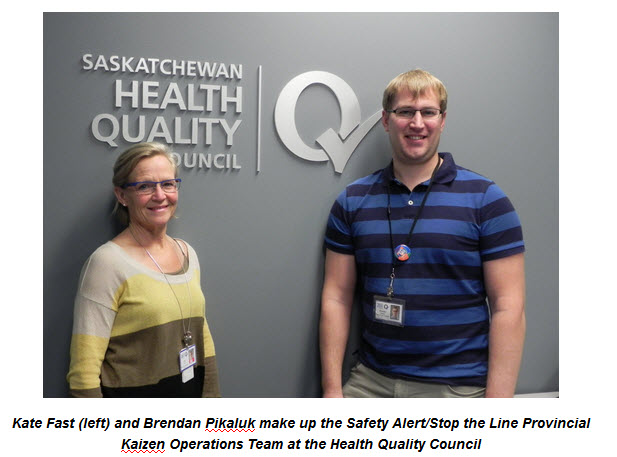A small team at the Health Quality Council (HQC) is focused on strengthening the culture of safety in all Saskatchewan health care environments and preventing potentially harmful situations from occurring.
HQC employees Kate Fast and Brendan Pikaluk make up the Safety Alert/Stop the Line Provincial Kaizen Operations Team (SA/STL PKOT), which is housed at HQC. Both have clinical backgrounds – Fast as a physical therapist and Pikaluk as an exercise therapist – and both are passionate about protecting the safety of patients and health care employees.
“While many experiences go well, people are being harmed in our health system – both those who are seeking care, as well as those who are providing it,” said Pikaluk, a project and policy consultant with the SA/STL PKOT.
“The health system is supposed to be where people go to heal. Employees care about their patients and want to provide the very best care. It’s the system that has been set up that allows for defects and errors to reach patients. It is my passion to continuously seek improvement in our system so that patients receive the care that they need and providers can provide the care that they want to give,” he said.
Fast said nearly 200 patients were seriously harmed in Saskatchewan in 2014-2015, while more than 2,400 employees were injured in health care settings in the province last year. It’s a situation that she believes must change – and soon.
“Staff and providers come to work in the health system to make a positive difference for members of their community. They do not intend harm to patients, and are not prepared to be harmed themselves in the performance of their duties,” said Fast, who serves as the lead for the SA/STL PKOT.
“Our goal is to ensure the system is designed to assist care providers in identifying potential harm, and stopping it before it happens.”
Fortunately, improving safety in health care settings is a top priority in Saskatchewan. The Safety Alert/Stop the Line (SA/STL) strategy is a provincial initiative that intends to build a safety culture and make health care environments safer for patients, employees, and health care providers. The initiative encompasses processes, policies, and behavioural expectations that support patients, staff, and physicians to be safety inspectors, to identify and fix potentially harmful mistakes in the moment, or to “stop the line” and call for additional help to restore safety.
The role of the SA/STL PKOT is to coordinate and support the implementation of the strategy in all Saskatchewan health care settings by 2018. Implementation of the SA/STL strategy will help Saskatchewan’s health system to achieve its goal of zero harm to patients and staff by March 31, 2020.
“The SA/STL process will also drive a change in the alignment of safety expertise and resources,” Fast said.
“Improved information flow will necessitate that those with safety expertise are available to point-of-care providers following a ‘stop the line’ incident to coach and support teams in root cause analysis. In addition, improvements in safety incident reporting will result in trending and analysis so that health system leaders can make informed decisions about where to invest strategically to decrease risk overall.
“Changes in work and information flows will build the health system’s capacity to be proactive, continuously reducing risk and making health care environments safer year over year.”
Fast describes HQC as an “accelerant” to move the SA/STL process forward. Fast and Pikaluk help to coordinate the safety work in Saskatchewan and support the spread of the initiative across the health system.
“We work with all health regions and system partners to ‘think and act as one’ to collaboratively build provincial SA/STL definitions, standards, and processes,” Fast said.
“This alignment and symmetry in all health care environments is important because although patients, staff, and providers move between health regions, the standards for safe behaviour and the response to potentially harmful situations need to be the same everywhere.
“HQC also has access to health data and the expertise to analyze and interpret it. This allows us to measure our work to see if it is moving forward and resulting in the desired outcome.”
Saskatoon Health Region is a Saskatchewan health region that has demonstrated its commitment to improving safety. In launching its Safer Every Day 90-day initiative on Sept. 15, 2015, the health region identified the safety of its patients, residents, clients, and staff as its number one priority. Through its 90-day initiative, the region is aiming to achieve “new breakthrough approaches to safety issues” that can have an impact on care and address organizational challenges that can be barriers to preventing harm.
HQC’s board chair, Dr. Susan Shaw, is very involved in Saskatoon Health Region’s 90-day initiative. Shaw, who practices critical care and anesthesiology, is team co-lead for the initiative, along with Petrina McGrath, the health region’s vice-president of people, practice and quality.
During its Safer Every Day launch, Saskatoon Health Region also shared the story of a four-year-old boy who almost died in hospital in May 2014 when he was given a concentration of potassium chloride that was five times too high.
“From our patients, physicians, and employees, we heard that we need to talk about near misses and harmful events more openly in order to learn how to make the region safer,” Shaw said.
“When harm occurs, patients, families, and their health care providers are all affected, and they all require support. The patient must come first, and we also need to ensure that our teams have the right skills, information, and support to solve unsafe situations before harm happens and to provide the correct supports when it does.”
Fast said making health care settings safer is everyone’s responsibility. She is pleased to see Saskatchewan’s health system focusing on safety goals.
“The change I see and hear this year is that safety is becoming a priority for point-of-care staff and leaders,” she said.
“On acute care units across the province, safety is a topic at daily huddles, and patient and staff risks are being identified and communicated daily.
“At the very basic level, safe care is in the hands of each person in every health care setting. It is up to us to choose to be safe and to take the time to check for defects. These are the behaviour changes that the SA/STL initiative is about, and it’s what I’m starting to see in the health system.”
Making care SAFER means:
S: Stop if you see something that is unsafe.
A: Assess the situation. Ask for support from others, supervisors, or leaders.
F: Fix the unsafe situation if you can. If you can’t, then . . .
E: Escalate your concern. Call in help from a team member or leader.
R: Report unsafe situations, environments, and practices, including both instances of no harm and incidents that have resulted in harm to patients or staff.



